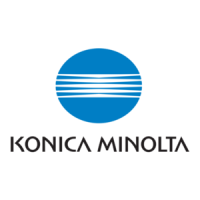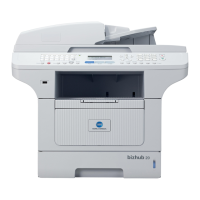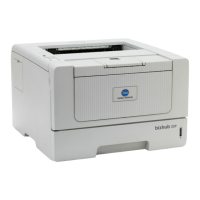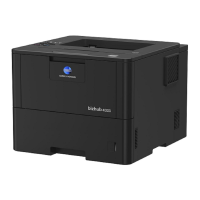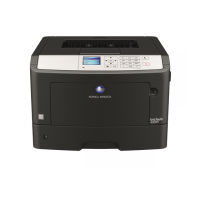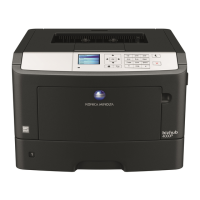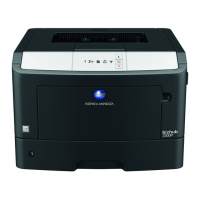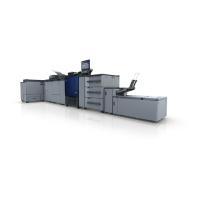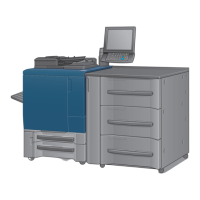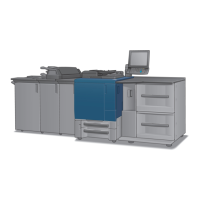Do you have a question about the Konica Minolta Network Printer and is the answer not in the manual?
Welcome message and overview of the manual's content and purpose.
Details the capabilities and functions of the Konica Force 65 Network Printing System.
Essential safety information for operating the machine safely.
Explains the location and meaning of safety labels on the machine.
Compliance with FCC, Canadian, and FDA regulations.
Cautions for safe installation and electrical connections.
Guidelines for safe operation, maintenance, and preventing damage.
General safety practices for checks, toner, paper, and cleaning.
Paper capacity limits for the finisher to prevent misfeeds.
General overview of the printer's capabilities and architecture.
Access and use of the Key Operator mode for advanced settings.
Information on professional service, recommended supplies, and maintenance.
Details on labels providing instructions for operation and safety.
Settings configurable by service representatives, including passwords and capacities.
Identification and description of external and internal machine components.
Physical space and environmental conditions needed for installation.
Explanation of the control panel buttons, screen, and their functions.
Technical data including engine speed, paper handling, and dimensions.
Paper size, weight, and capacity details for the printer's internal trays.
Paper compatibility and capacity for the optional LT-402 tray.
Paper compatibility and capacity for the optional LT-412 tray.
Paper size and weight compatibility for the automatic duplexing feature.
Paper size, weight, and capacity for the multi-sheet bypass tray.
Paper sizes and capacities for the FS-110/210 Finisher.
Paper details for the PI-110 Cover Sheet Feeder.
Paper specifications and hole punch details for the PK kits.
Paper details and folding/punching capabilities for the PZ-108 unit.
Explains on-screen messages related to paper status and selection.
Chart detailing paper weight compatibility across machine components.
Overview of control panel, screens, and basic operations.
Initial screen sequence upon printer power-on.
Warm-up sequence and display indicating fixing temperature.
Explanation of the control panel layout and key functions.
Components of the basic screen: message, icon, and job control areas.
Messages related to temporary stop functions displayed on the basic screen.
Viewing job settings and making changes via the check screen.
Displays the reservation list and status of reserved jobs.
Accessing help information and Key Operator mode via the HELP key.
Procedures for temporarily suspending or canceling a print job.
How to change the priority of reserved jobs.
Steps for deleting jobs from the queue and confirming deletion.
Displaying and navigating the list of completed jobs.
Displaying and navigating the list of incomplete jobs.
Modifying job settings when mixed originals cause printing to stop.
Selecting paper type and size for the multi-sheet bypass tray.
Explains the sections and functions of the controller screen.
Energy saving feature that lowers fixing temperature during inactivity.
Viewing and printing total counter and start date information.
Information on the printer's weekly timer for power management.
Paper sizes, weights, and capacities for the FS-110/210 Finisher.
Explains Non-Sort, Sort/Group, and Staple-Sort modes for the primary tray.
Describes Non-sort and Group exit modes for the secondary tray.
Paper compatibility and capacities for the FS-210 finisher's booklet tray.
Paper details for the PI-110 Cover Sheet Feeder.
Paper specifications and hole punch details for the PK kits.
Paper details and Z-folding/punching capabilities for the PZ-108 unit.
Non-sort output mode for the primary tray with face-down stacking.
Sort mode for offset sets with face-down output.
Staple-sort mode for offset and stapled sets with face-down output.
Folding and stapling/folding modes for the FS-210 finisher's booklet tray.
Punch mode for hole punching output prints.
Z-folding mode for creating Z-folded prints.
Three-folding mode for creating folded prints.
Using the cover sheet feeder for adding front or booklet covers.
Instructions for manual stapling, punching, and folding operations.
Describes output modes when no finisher is installed.
Instructions for accessing and using machine web utilities via a browser.
Displaying machine configuration and option info via web utilities.
Viewing job status, lists, and historical job info via web utilities.
Configuring network settings, including E-mail transmission, via web utilities.
Using paper indicators and loading paper into trays.
Step-by-step guide for replacing the toner cartridge.
Procedure for replacing the staple cartridge in the finisher.
Instructions for emptying the trash basket of the punching kit.
Instructions for emptying the trash basket of the Z-folding unit.
Information on required PM and how to read/print the PM counter.
Details on contacting service, repairs, and ordering supplies.
How to clear paper jams and use the jam location screen.
Troubleshooting tips for common printing issues and error messages.
Explains the role and capabilities of a Key Operator.
Steps to enter Key Operator mode using passwords and the help screen.
Map detailing functions and sub-functions in Key Operator mode.
Setting printer's initial conditions: date, time, language, IP address.
Monitoring printing activity, user accounts, and setting limits via ECM.
Specifying paper types and special sizes for each tray.
Adjusting touch screen brightness, contrast, and key sound volume.
Entering the Key Operator's name and telephone extension.
Information on the printer's weekly timer function for power management.
Checking and realigning the LCD touch screen sensors.
Configuring tray size detection and priority for ATS/APS functions.
Setting intervals for Auto Low Power and Auto Shut Off modes.
Changing various machine settings via memory switches.
Printing lists of user, ECM, and font pattern management.
Initiating remote diagnostics and contacting service for machine issues.
Setting adjustment data for magnification ratio for each tray.
Making fine adjustments to finisher functions like stapling and folding.
Welcome message and overview of the manual's content and purpose.
Details the capabilities and functions of the Konica Force 65 Network Printing System.
Essential safety information for operating the machine safely.
Explains the location and meaning of safety labels on the machine.
Compliance with FCC, Canadian, and FDA regulations.
Cautions for safe installation and electrical connections.
Guidelines for safe operation, maintenance, and preventing damage.
General safety practices for checks, toner, paper, and cleaning.
Paper capacity limits for the finisher to prevent misfeeds.
General overview of the printer's capabilities and architecture.
Access and use of the Key Operator mode for advanced settings.
Information on professional service, recommended supplies, and maintenance.
Details on labels providing instructions for operation and safety.
Settings configurable by service representatives, including passwords and capacities.
Identification and description of external and internal machine components.
Physical space and environmental conditions needed for installation.
Explanation of the control panel buttons, screen, and their functions.
Technical data including engine speed, paper handling, and dimensions.
Paper size, weight, and capacity details for the printer's internal trays.
Paper compatibility and capacity for the optional LT-402 tray.
Paper compatibility and capacity for the optional LT-412 tray.
Paper size and weight compatibility for the automatic duplexing feature.
Paper size, weight, and capacity for the multi-sheet bypass tray.
Paper sizes and capacities for the FS-110/210 Finisher.
Paper details for the PI-110 Cover Sheet Feeder.
Paper specifications and hole punch details for the PK kits.
Paper details and folding/punching capabilities for the PZ-108 unit.
Explains on-screen messages related to paper status and selection.
Chart detailing paper weight compatibility across machine components.
Overview of control panel, screens, and basic operations.
Initial screen sequence upon printer power-on.
Warm-up sequence and display indicating fixing temperature.
Explanation of the control panel layout and key functions.
Components of the basic screen: message, icon, and job control areas.
Messages related to temporary stop functions displayed on the basic screen.
Viewing job settings and making changes via the check screen.
Displays the reservation list and status of reserved jobs.
Accessing help information and Key Operator mode via the HELP key.
Procedures for temporarily suspending or canceling a print job.
How to change the priority of reserved jobs.
Steps for deleting jobs from the queue and confirming deletion.
Displaying and navigating the list of completed jobs.
Displaying and navigating the list of incomplete jobs.
Modifying job settings when mixed originals cause printing to stop.
Selecting paper type and size for the multi-sheet bypass tray.
Explains the sections and functions of the controller screen.
Energy saving feature that lowers fixing temperature during inactivity.
Viewing and printing total counter and start date information.
Information on the printer's weekly timer for power management.
Paper sizes, weights, and capacities for the FS-110/210 Finisher.
Explains Non-Sort, Sort/Group, and Staple-Sort modes for the primary tray.
Describes Non-sort and Group exit modes for the secondary tray.
Paper compatibility and capacities for the FS-210 finisher's booklet tray.
Paper details for the PI-110 Cover Sheet Feeder.
Paper specifications and hole punch details for the PK kits.
Paper details and Z-folding/punching capabilities for the PZ-108 unit.
Non-sort output mode for the primary tray with face-down stacking.
Sort mode for offset sets with face-down output.
Staple-sort mode for offset and stapled sets with face-down output.
Folding and stapling/folding modes for the FS-210 finisher's booklet tray.
Punch mode for hole punching output prints.
Z-folding mode for creating Z-folded prints.
Three-folding mode for creating folded prints.
Using the cover sheet feeder for adding front or booklet covers.
Instructions for manual stapling, punching, and folding operations.
Describes output modes when no finisher is installed.
Instructions for accessing and using machine web utilities via a browser.
Displaying machine configuration and option info via web utilities.
Viewing job status, lists, and historical job info via web utilities.
Configuring network settings, including E-mail transmission, via web utilities.
Using paper indicators and loading paper into trays.
Step-by-step guide for replacing the toner cartridge.
Procedure for replacing the staple cartridge in the finisher.
Instructions for emptying the trash basket of the punching kit.
Instructions for emptying the trash basket of the Z-folding unit.
Information on required PM and how to read/print the PM counter.
Details on contacting service, repairs, and ordering supplies.
How to clear paper jams and use the jam location screen.
Troubleshooting tips for common printing issues and error messages.
Explains the role and capabilities of a Key Operator.
Steps to enter Key Operator mode using passwords and the help screen.
Map detailing functions and sub-functions in Key Operator mode.
Setting printer's initial conditions: date, time, language, IP address.
Monitoring printing activity, user accounts, and setting limits via ECM.
Specifying paper types and special sizes for each tray.
Adjusting touch screen brightness, contrast, and key sound volume.
Entering the Key Operator's name and telephone extension.
Information on the printer's weekly timer function for power management.
Checking and realigning the LCD touch screen sensors.
Configuring tray size detection and priority for ATS/APS functions.
Setting intervals for Auto Low Power and Auto Shut Off modes.
Changing various machine settings via memory switches.
Printing lists of user, ECM, and font pattern management.
Initiating remote diagnostics and contacting service for machine issues.
Setting adjustment data for magnification ratio for each tray.
Making fine adjustments to finisher functions like stapling and folding.
| Brand | Konica Minolta |
|---|---|
| Model | Network Printer |
| Category | Printer |
| Language | English |
